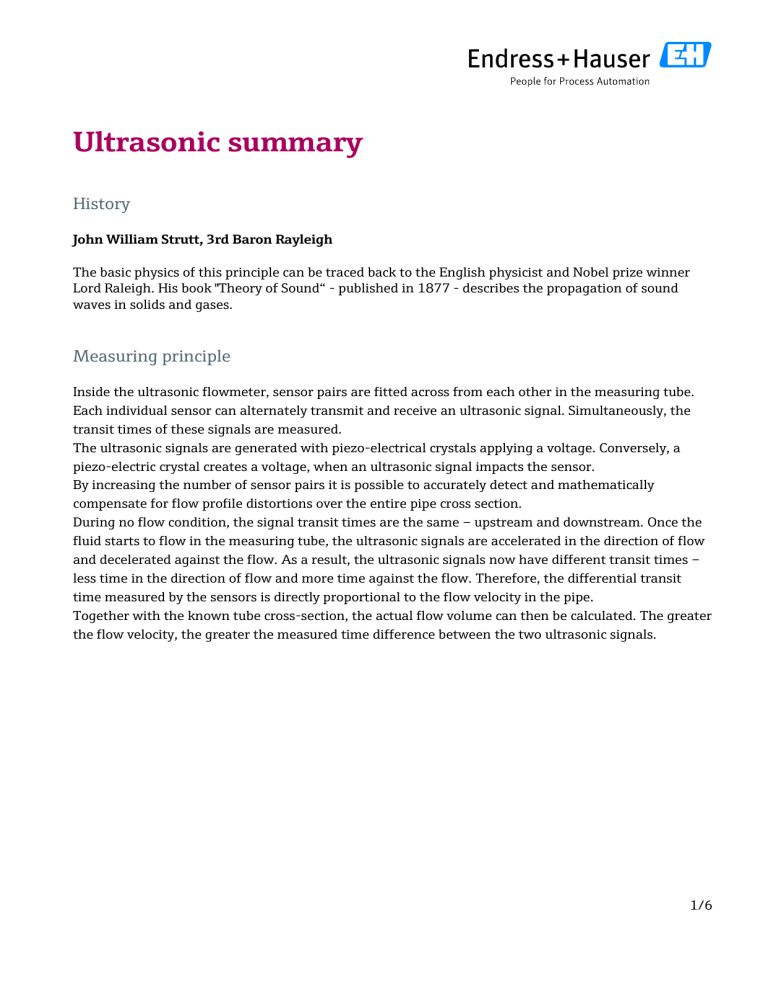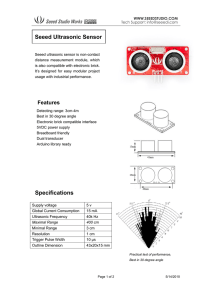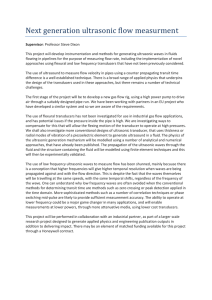
Ultrasonic summary History John William Strutt, 3rd Baron Rayleigh The basic physics of this principle can be traced back to the English physicist and Nobel prize winner Lord Raleigh. His book "Theory of Sound“ - published in 1877 - describes the propagation of sound waves in solids and gases. Measuring principle Inside the ultrasonic flowmeter, sensor pairs are fitted across from each other in the measuring tube. Each individual sensor can alternately transmit and receive an ultrasonic signal. Simultaneously, the transit times of these signals are measured. The ultrasonic signals are generated with piezo-electrical crystals applying a voltage. Conversely, a piezo-electric crystal creates a voltage, when an ultrasonic signal impacts the sensor. By increasing the number of sensor pairs it is possible to accurately detect and mathematically compensate for flow profile distortions over the entire pipe cross section. During no flow condition, the signal transit times are the same – upstream and downstream. Once the fluid starts to flow in the measuring tube, the ultrasonic signals are accelerated in the direction of flow and decelerated against the flow. As a result, the ultrasonic signals now have different transit times – less time in the direction of flow and more time against the flow. Therefore, the differential transit time measured by the sensors is directly proportional to the flow velocity in the pipe. Together with the known tube cross-section, the actual flow volume can then be calculated. The greater the flow velocity, the greater the measured time difference between the two ultrasonic signals. 1/6 Basic meter construction Ultrasonic Clamp-on Transmitter Amplifies and filters signals, computes relevant data (totalizer, flowrate), generates interface signals (Hart, Profibus etc). Is the human machine interface (HMI) and display. For Clamp-on sensors it will always be a remote version. Sensor Contains all parts and functions of the device to send and collect the signal. Process connection In this case, the Process connection consists of the sensor holders, a ruler to ensure the correct installation position and two mounting bands Installed on the outside of the pipe • Simple retrofit, low installation cost • Not calibrated, limited accuracy • No contact to the fluid • 2/6 Ultrasonic Inline Transmitter Amplifies and filters signals, computes relevant data (totalizer, flowrate), generates interface signals (Hart, Profibus etc). Is the human machine interface (HMI) and display. It can be mounted integrally or remote, depending on the installation situation. Sensor Comprises all parts and functions of the device mounted in the pipe Process connection It provides connection to customer process piping. Choose from many options. “Regular” flowmeter installed in the pipe • Calibrated and accurate • For any low viscous liquid applicable • The advantages of the ultrasonic inline flow meters overcome some of the disadvantages of other flow metering technologies and are therefore often used to substitute these. 3/6 Advantages • • • • • • Measures also non-conductive liquids No pressure loss No moving parts High turn-down Calibrated accuracy (only inline ultrasonic) No contact to the fluid (only ultrasonic clamp-on) Limitations Not suitable for non-acoustical transmitting fluids (rare) • Not recommended for dirty liquids (>5% solids, >2% gas) • 4/6 Application examples Oil & Gas e.g. Inexpensive volume measurement of hydrocarbons Chemical e.g. Steam condensate Life Science e.g. Ultrapure water monitoring in ring mainpipe 5/6 Water & Wastewater e.g. Biogas measurement at gas engine Food & Beverage e.g. Palm oil measurement 6/6



